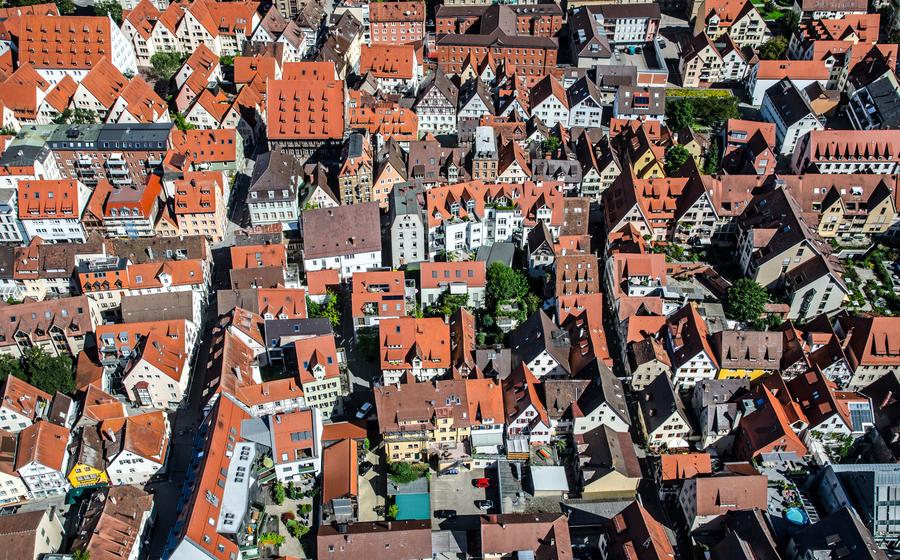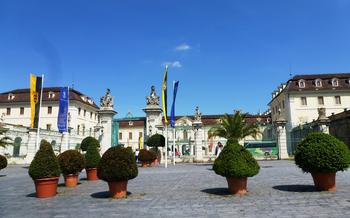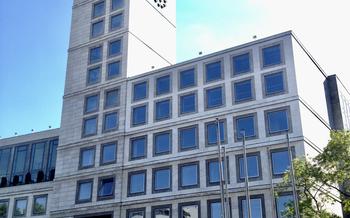
The Archaeopark Vogelherd (not in Ulm but in Niederstotzingen)
- The Archaeopark Vogelherd
- Ice Age Art and Mammoth Hunters
- The Vogelherd Caves: A Journey into the Past
- Geological Formation and History
- Guided Tours and Exploration
- Safety Measures and Precautions
- Prehistoric Settlements
- Museum Exhibitions
- Outdoor Activities
- Guided Tours and Workshops
- Special Events and Festivals
- Educational Programs
- Research and Conservation
- Accessibility and Facilities
- Nearby Attractions
- Local Cuisine and Restaurants
- Accommodation and Hotels
- Insider Tip: Unveiling the Secrets of the Archaeopark
The Archaeopark Vogelherd
The Archaeopark Vogelherd is a unique and fascinating destination that offers a glimpse into the lives of our prehistoric ancestors. Located in Niederstotzingen, Germany, the park is home to the Vogelherd Caves, which have yielded a wealth of Ice Age artifacts, including some of the oldest known figurative art in the world.
The park's interactive exhibits and displays bring the Ice Age to life, allowing visitors to learn about the mammoth hunters who once roamed the region and the incredible art they left behind. With its stunning natural scenery, rich history, and engaging educational experiences, the Archaeopark Vogelherd is a must-visit for anyone interested in archaeology, prehistory, and the wonders of the natural world.
Ice Age Art and Mammoth Hunters
The Archaeopark Vogelherd is renowned for its exceptional collection of Ice Age art, providing a glimpse into the artistic expressions and cultural practices of our prehistoric ancestors. Within the Vogelherd Caves, visitors can marvel at intricate engravings and carvings on animal bones and antlers, depicting a variety of animals, hunting scenes, and abstract symbols. These remarkable works of art offer a unique perspective on the symbolic and ritualistic beliefs of the early inhabitants of the region.
The site also holds significant archaeological importance due to the presence of mammoth bones and tools associated with mammoth hunting. Excavations have revealed evidence of hunting strategies and techniques employed by the Neanderthals and early modern humans who inhabited the area during the Ice Age. The discovery of butchered mammoth bones, stone tools, and hunting pits provides insights into the subsistence practices and technological advancements of these ancient populations.
The Vogelherd Caves: A Journey into the Past
Geological Formation and History
The Vogelherd Caves are a system of seven interconnected caves located in the Swabian Jura, a region known for its rich fossil record. The caves were formed millions of years ago by the erosive power of water seeping through the limestone rock. Over time, the water dissolved the rock, creating a network of tunnels, chambers, and shafts.
The caves have a long and complex history, dating back to the Ice Age. During this period, the caves were inhabited by humans and animals, who left behind a wealth of artifacts and evidence of their daily lives. The caves were also used as a burial ground, and the remains of several individuals have been found inside.
Guided Tours and Exploration
Visitors to the Archaeopark Vogelherd can explore the caves on a guided tour. The tours are led by experienced guides who provide insights into the geology, history, and archaeology of the caves. Visitors will learn about the different types of rocks found in the caves, the formation of the caves, and the evidence of human and animal activity.
The tours also include a visit to the Vogelherd Museum, which houses a collection of artifacts found in the caves. The museum displays tools, weapons, jewelry, and other objects that provide a glimpse into the lives of the people who inhabited the caves during the Ice Age.
Safety Measures and Precautions
The Vogelherd Caves are a safe and accessible destination for visitors of all ages. However, there are a few safety measures and precautions that visitors should take. The caves are dark and slippery, so it is important to wear sturdy shoes and bring a flashlight. Visitors should also be aware of the potential for falling rocks and should stay on the marked paths.
Children should be closely supervised while exploring the caves. The caves are not suitable for people with claustrophobia or other medical conditions that may be aggravated by confined spaces.
Prehistoric Settlements
The Archaeopark Vogelherd offers a glimpse into the lives of prehistoric humans who inhabited the region thousands of years ago. Archaeological excavations at the site have revealed evidence of prehistoric settlements, including the remains of dwellings, tools, and other artifacts.
One of the highlights of the park is the reconstruction of a Stone Age settlement, which provides visitors with a realistic impression of how early humans lived. The settlement features several huts made of wood and animal skins, as well as a variety of tools and implements that were used for hunting, gathering, and everyday tasks.
Visitors can explore the settlement and learn about the daily life and culture of early humans, such as their hunting techniques, their methods for making tools and clothing, and their social customs. The settlement also provides an opportunity to see how the landscape has changed over time and how humans have adapted to their environment.
Museum Exhibitions
The Archaeopark Vogelherd features a range of permanent and temporary exhibitions that delve into the fascinating world of archaeology and prehistory. Visitors can embark on a journey through time as they explore the diverse artifacts, displays, and interactive installations that showcase the region's rich cultural heritage.
Permanent exhibits focus on the Ice Age art, mammoth hunters, and prehistoric settlements that once thrived in the area. Visitors can marvel at the exquisite craftsmanship of the Venus figurines, which are among the oldest known works of art in the world. The exhibits also provide insights into the daily lives of the mammoth hunters, their hunting techniques, and the significance of the mammoth in prehistoric society.
Temporary exhibitions at the Archaeopark offer a fresh perspective on various aspects of archaeology and prehistory. These exhibitions often feature the latest research findings, showcasing new discoveries and shedding light on the ever-evolving understanding of our past. Visitors can expect to encounter a diverse range of artifacts, from ancient tools and weapons to pottery and jewelry, each telling a unique story about the people who inhabited this region thousands of years ago.
Interactive displays and hands-on activities enhance the museum experience, making it both educational and engaging for visitors of all ages. Children and adults alike can participate in hands-on workshops, try their hand at flintknapping, learn about ancient crafts and technologies, and even dress up in prehistoric costumes. These interactive elements bring the past to life, allowing visitors to experience the wonders of prehistory in a truly immersive way.
Outdoor Activities
Beyond the fascinating exhibits and immersive experiences, the Archaeopark Vogelherd offers a range of outdoor activities that allow visitors to connect with nature and explore the surrounding landscape. A network of well-maintained hiking trails winds through the park, inviting visitors to embark on leisurely walks or challenging treks. These trails offer breathtaking views of the picturesque countryside, with rolling hills, lush forests, and idyllic meadows.
Designated picnic areas and resting spots are scattered throughout the park, providing opportunities for visitors to relax and enjoy a leisurely meal surrounded by nature's beauty. These spots are ideal for families and groups to gather, share a picnic lunch, and soak in the tranquil atmosphere.
The park also provides opportunities for birdwatching and wildlife observation. The diverse habitats within the park support a rich array of bird species, including woodpeckers, nuthatches, and various songbirds. Visitors can bring their binoculars and cameras to capture the beauty of these feathered creatures in their natural environment.
Guided Tours and Workshops
Complement your visit to the Archaeopark Vogelherd with guided tours and workshops that offer unique insights into prehistoric life. Knowledgeable guides lead visitors through the caves, explaining the significance of the Ice Age art and the discoveries made by archaeologists. Interactive workshops provide hands-on experiences, allowing participants to learn about flintknapping, tool-making, and other ancient crafts. Storytelling sessions transport visitors back in time, bringing the stories of the mammoth hunters and early humans to life. Educational programs tailored for families engage children and adults alike, fostering a deeper understanding of our prehistoric ancestors.
Special Events and Festivals
The Archaeopark Vogelherd comes alive during special events and festivals that celebrate prehistoric culture and heritage. These events offer a unique opportunity for visitors to immerse themselves in the past and experience the traditions and skills of our ancestors.
One of the most popular events is the annual Prehistoric Festival, held in the summer months. During this festival, the park transforms into a vibrant showcase of ancient crafts, demonstrations, and performances. Visitors can witness skilled flintknappers creating tools, learn about traditional pottery techniques, and watch as experts demonstrate ancient hunting methods.
Another highlight is the Cave Art Festival, which takes place in the fall. This festival celebrates the incredible Ice Age art found in the Vogelherd Caves. Visitors can participate in hands-on workshops on cave painting and engraving, guided tours of the caves, and storytelling sessions that bring the Ice Age to life.
These festivals are a fantastic opportunity to engage with the past in a fun and interactive way. They offer a glimpse into the lives of our prehistoric ancestors and provide a deeper understanding of their culture and traditions.
Educational Programs
The Archaeopark Vogelherd offers a wide range of educational programs and resources for schools and visitors of all ages. School groups can book guided tours and workshops tailored to their curriculum, allowing students to engage with prehistoric history in a hands-on and interactive way. Educational materials, including lesson plans, activity sheets, and multimedia presentations, are available for teachers to incorporate into their classroom lessons.
Field trips and outdoor learning experiences are also encouraged, providing students with the opportunity to explore the park's natural surroundings and learn about the region's rich cultural heritage. Interactive learning stations throughout the park invite visitors to discover more about the Ice Age and its inhabitants through hands-on activities, storytelling sessions, and demonstrations of ancient crafts.
The Archaeopark also collaborates with universities and research institutions to develop innovative educational programs and workshops. These programs often focus on specific aspects of prehistoric archaeology, such as flintknapping, tool-making, and the analysis of ancient artifacts. Visitors can participate in these workshops and learn from experts in the field, gaining a deeper understanding of the region's prehistoric past.
By offering a variety of educational programs and resources, the Archaeopark Vogelherd aims to inspire future generations of archaeologists and history enthusiasts. Through hands-on learning experiences and interactive displays, the park brings the Ice Age to life and fosters a greater appreciation for our prehistoric ancestors.
Research and Conservation
The Archaeopark Vogelherd is not only a place of public education and entertainment but also an active center for ongoing research and conservation efforts. A team of archaeologists, paleontologists, and other experts collaborate to further our understanding of the Ice Age and its inhabitants.
The park collaborates closely with universities and research institutions worldwide to advance knowledge in various fields, including archaeology, geology, and environmental studies. These collaborations facilitate the exchange of ideas, expertise, and resources, leading to groundbreaking discoveries and a deeper understanding of our prehistoric past.
Conservation plays a crucial role in protecting the unique cultural heritage preserved at the Archaeopark. The team works diligently to maintain and safeguard the archaeological sites, artifacts, and natural surroundings. This includes implementing measures to prevent erosion, monitor climate conditions, and ensure the long-term preservation of the caves and their contents.
Through these ongoing research and conservation initiatives, the Archaeopark Vogelherd contributes significantly to the preservation of our cultural heritage and the advancement of scientific knowledge.
Accessibility and Facilities
The Archaeopark Vogelherd is committed to providing an inclusive and accessible experience for all visitors. Accessibility features include ramps, elevators, and designated parking spaces for individuals with disabilities. Well-maintained pathways throughout the park ensure that everyone can easily navigate the grounds. Restrooms are conveniently located, and a visitor information center staffed with helpful and knowledgeable personnel is ready to assist with any queries or provide further information. Additionally, the park offers a café where visitors can relax and enjoy refreshments while immersing themselves in the prehistoric ambiance.
Nearby Attractions
The Archaeopark Vogelherd is situated in the picturesque region of Baden-Württemberg, offering a wealth of attractions beyond its prehistoric wonders. History buffs can delve into the medieval charm of nearby Heidenheim an der Brenz, with its well-preserved castle and historic city center. For a touch of art and culture, the Ulmer Museum in Ulm boasts an impressive collection of modern and contemporary art. Nature enthusiasts will delight in exploring the Swabian Alb Biosphere Reserve, with its stunning landscapes, hiking trails, and opportunities for wildlife observation.
Combining history and nature, Schloss Hellenstein in Heidenheim is a magnificent Renaissance castle perched atop a hill, offering breathtaking views of the surrounding countryside. Take a leisurely stroll through the charming village of Neresheim, with its baroque abbey and tranquil atmosphere. Immerse yourself in the world of fossils and dinosaurs at the Urweltmuseum Hauff in Holzmaden, home to a fascinating collection of prehistoric finds.
Plan a multi-day trip to discover the diverse attractions of the region. Start with a visit to the Archaeopark Vogelherd, then explore the medieval treasures of Heidenheim and Ulm. Dedicate a day to hiking and nature exploration in the Swabian Alb Biosphere Reserve, and wrap up your journey with a visit to Schloss Hellenstein and the Urweltmuseum Hauff. This itinerary promises a well-rounded experience, blending prehistoric wonders with historical charm and natural beauty.
Local Cuisine and Restaurants
When visiting the Archaeopark Vogelherd, take the opportunity to savor the flavors of the region. Niederstotzingen and its surroundings offer a range of culinary experiences, from traditional Swabian cuisine to international delights.
For an authentic taste of Swabia, try dishes like Maultaschen (large ravioli filled with minced meat, spinach, and herbs), Spätzle (egg noodles), and Käsespätzle (cheese noodles). These hearty dishes are often served with a side of salad or sauerkraut.
Don't miss the chance to sample the region's famous Schupfnudeln (potato dumplings) or Linsen mit Spätzle (lentils with egg noodles). For a sweet treat, indulge in Ofenschlupfer (baked bread dumplings with fruit filling) or Zwiebelkuchen (onion tart).
Niederstotzingen has several restaurants and cafés where you can enjoy local cuisine. Look for establishments that use fresh, seasonal ingredients and offer traditional recipes. Many restaurants also have outdoor seating, allowing you to soak up the beautiful surroundings while you dine.
For those with dietary restrictions, vegetarian and vegan options are becoming increasingly available in the region. Several restaurants offer plant-based dishes, such as Maultaschen filled with tofu or vegetables, Veggie-Spätzle, and a variety of salads and soups.
To fully immerse yourself in the local culinary culture, consider attending one of the many food festivals held throughout the year. These events showcase regional specialties, traditional cooking demonstrations, and opportunities to sample a wide range of dishes.
Whether you're looking for a hearty Swabian meal or a lighter vegetarian option, Niederstotzingen and its surroundings offer a diverse range of culinary experiences that will delight your taste buds and enhance your visit to the Archaeopark Vogelherd.
Accommodation and Hotels
For a comfortable stay, Niederstotzingen and the surrounding towns offer a range of accommodation options. Whether you prefer budget-friendly hostels or luxurious hotels, there's something to suit every traveler.
Within Niederstotzingen itself, the Hotel Gasthof zum Ochsen is a charming family-run hotel with traditional rooms and a cozy atmosphere. For a more modern experience, the Hotel Adler offers stylish rooms and a rooftop terrace with panoramic views of the town.
If you're looking for a unique stay, consider booking a room at the Schloss Niederstotzingen, a beautifully restored castle that offers a glimpse into the town's rich history.
To save on accommodation costs, consider staying in one of the nearby towns, such as Ulm or Heidenheim. These towns offer a wider range of hotels and hostels, as well as easy access to the Archaeopark by public transportation or car.
When booking your accommodations, it's advisable to reserve in advance, especially during peak tourist season or if you're traveling with a group. Online booking platforms and local tourism offices can provide information and assistance in finding the perfect place to stay.
Insider Tip: Unveiling the Secrets of the Archaeopark
As you embark on your journey through the Archaeopark Vogelherd, embrace the opportunity to uncover its hidden treasures. Stray from the beaten path and seek out the secluded nooks and crannies that hold secrets waiting to be discovered. Venture into the lesser-known corners of the park to find unique perspectives and capture breathtaking photographs that will serve as lasting mementos of your visit.
Engage with the knowledgeable staff and inquire about special events or workshops that may not be widely advertised. These exclusive experiences offer a deeper dive into the park's history and provide a chance to connect with experts in the field.
Plan your visit strategically to avoid the peak tourist hours and relish the tranquility of the park in the early morning or late afternoon. This serene ambiance allows for a more immersive and personal connection with the ancient wonders that surround you.
Embrace the opportunity to participate in hands-on activities and workshops that transport you back in time. Engage in flintknapping, craft your own tools, or immerse yourself in storytelling sessions that bring the prehistoric era to life. These interactive experiences provide a tangible connection to the past and create lasting memories.
Finally, remember to savor the culinary delights of the region. Indulge in traditional dishes that have been passed down through generations, reflecting the rich cultural heritage of the area. Sample local specialties and immerse yourself in the flavors that have shaped the region's identity.









